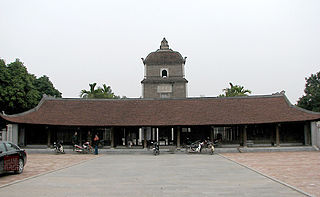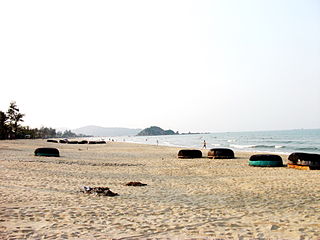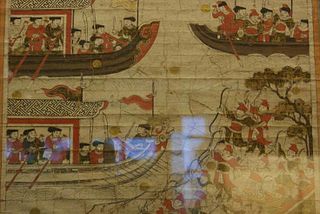Related Research Articles

Hanoi is the capital city of Vietnam in the north of Vietnam. It covers an area of 3,358.6 km2 (1,296.8 sq mi). The second largest city in Vietnam, it consists of 12 urban districts, 1 district-leveled town and 17 rural districts. Located within the Red River Delta, Hanoi is the cultural and political centre of Vietnam.

Tonkin, also spelled Tongkin, Tonquin or Tongking, is an exonym referring to the northern region of Vietnam. During the 17th and 18th centuries, this term referred to the domain Đàng Ngoài under Trịnh lords' control, including both the Northern and Thanh-Nghệ regions, north of the Gianh River. From 1884 to early 1945, this term was used for the French protectorate of Tonkin, composed of only the Northern region.

Champa was a collection of independent Cham polities that extended across the coast of what is today central and southern Vietnam from approximately the 2nd century AD until 1832, when it was annexed by the Vietnamese Empire under Minh Mạng. The kingdom was known variously as Nagaracampa, ꨌꩌꨛꨩ in the Chamic and ចាម្ប៉ា in the Khmer inscriptions, Chiêm Thành in Sino-Vietnamese vocabulary and Zhànchéng in Chinese records.

Bắc Ninh is a province of Vietnam, located in the Red River Delta of the northern part of the country. It is the smallest province of Vietnam and is situated to the east of the nation's capital, Hanoi, and borders Bắc Giang Province, Hưng Yên Province, Hải Dương Province and Hanoi. The province covers an area of 822.71 square kilometres and as of 2019 it had a population of 1,368,840. The province's name literally means "northern serenity".

Ninh Bình is a province of Vietnam, in the Red River Delta region of the northern part of the country. The province is famous for a high density of natural and cultural attractions, including reserved parks in Cúc Phương National Park and Vân Long, grotto caves and rivers in Tràng An, Tam Cốc-Bích Động and Múa Caves, historic monuments in the Hoa Lư ancient capital, Vietnam's largest buddhist worshiping complex, and the Phát Diệm Cathedral with "eclectic architectural style". Thanks to its adjacency to Hanoi, day trips from the capital are easily manageable.

Central Highlands, Western Highlands or Midland Highlands is one of the regions of Vietnam. It contains the provinces of Đắk Lắk, Đắk Nông, Gia Lai, Kon Tum, Lâm Đồng.

Hưng Yên is a province in the Red River Delta of northern Vietnam. It covers an area of 930.22 km2 (359.2 sq mi), comprising 1 city, 8 rural districts, and 1 district-leveled town, with a population of over 1 million people as of 2019. The province is a settlement along the banks of the Red River, bordered by 5 provinces and municipalities.

Hải Dương is a city in Vietnam. It is the capital of Hải Dương Province and a highly industrialized province in the Hanoi Capital Region and the Red River Delta in Northern Vietnam. The city is at the midpoint between the capital Hanoi and major port Haiphong, and is part of the Northern Key Economic Zone. In 2019, Hai Duong city had a population of 507,469.

The Hồng Bàng period, also called the Hồng Bàng dynasty, was a legendary, semi-mythical period in Vietnamese historiography, spanning from the beginning of the rule of Kinh Dương Vương over the state of Văn Lang in 2879 BC until the conquest of the state by An Dương Vương in 258 BC.

The Lê dynasty, also known as Later Lê dynasty, was the longest-ruling Vietnamese dynasty, ruling Đại Việt from 1428 to 1789. The Lê dynasty is divided into two historical periods – the Early period or Lê sơ triều before usurpation by the Mạc dynasty (1527–1683), in which emperors ruled in their own right, and the restored period or Revival Lê, in which figurehead emperors reigned under the auspices of the powerful Trịnh family. The Restored Lê period is marked by two lengthy civil wars: the Lê–Mạc War (1533–1592) in which two dynasties battled for legitimacy in northern Vietnam and the Trịnh–Nguyễn War (1627-1672) between the Trịnh family in Tonkin and the Nguyễn lords of the South.

Nghệ An is a province in the North Central Coast region of Vietnam. It is Vietnam's largest province by area. Nghệ An is located in a central position in North Central Coast. To the east lies the Gulf of Tonkin; to the west the province is bordered by Laos; to the south Hà Tĩnh Province; and to the north is Thanh Hóa Province. It is located on the east–west economic corridor connecting Myanmar, Thailand, Laos and Vietnam along National Route 7 to the port of Cửa Lò.

Hòa Bình or Hoà Bình is a mountainous province of Vietnam, located in the nation's Northwest region. It borders Phú Thọ Province and Sơn La Province to the northwest, Hanoi to the northeast, Hà Nam Province to the east, Ninh Bình Province to the southeast and Thanh Hóa Province to the south. The province covers an area of 4590.57 square kilometres and as of 2019 it had a population of 854,131 people. In 2020, the GDP per capita of the province was estimated to be $2625.
The Trần Cao rebellion in 1516 is a rebellion in 16th century Vietnam, led by Trần Cao against the Lê dynasty and is regarded as an important factor leading to the collapse of the Early period Lê. It was the second rebellion led against the Lê, following an uprising led by Trần Tuân in 1511.

Đống Đa is one of the four original urban districts (quận) of Hanoi, the capital city of Vietnam. It is bordered by Ba Đình to the north, Hoàn Kiếm to the northeast, Hai Bà Trưng to the east, Thanh Xuân to the south, and Cầu Giấy to the west. The district currently has 21 wards, covering a total area of 9.95 square kilometers. It is the most populous district in Hanoi. As of 2017, there were 420900 people residing in the district, the population density is 42302 inhabitants per square kilometer, 18 times higher than the overall density of Hanoi. Dong Da District is home to various enterprises and many of Vietnam's most prestigious universities such as Hanoi Medical University, Foreign Trade University, University of Transport and Communications, Thuyloi University.

Ba Vì is a district of Hanoi, Vietnam. Ba Vì District was established on July 26, 1968.

Đàng Ngoài, also known as Tonkin, Bắc Hà or Annam Kingdom (安南國), was an area in northern Đại Việt during the 17th and 18th centuries as the result of Trịnh–Nguyễn War. The word "Đàng Ngoài" first appeared in the Dictionarium Annamiticum Lusitanum et Latinum by Alexandre de Rhodes.
The following is a timeline of the history of Hanoi, the capital city of Vietnam:

Tonkin (東京), or Bắc Kỳ (北圻), was a French protectorate encompassing modern Northern Vietnam. Like the French protectorate of Annam, Tonkin was still nominally ruled by the Nguyễn dynasty but in 1886 the French separated Tonkin from the Nguyễn imperial court in Huế by establishing the office of "Viceroy". However, on 26 July 1897 the position of Viceroy was abolished officially making the French Resident-Superior of Tonkin both the representative of the French colonial administration and the Nguyễn dynasty court in Huế giving him the power to appoint local mandarins. In 1887 Tonkin became a part of the Union of Indochina.

The Lê–Mạc War was a 44 year-long civil war waged between two Vietnamese dynasties, the Mạc and Revival Lê, during the Southern and Northern Dynasties period of Vietnamese history.